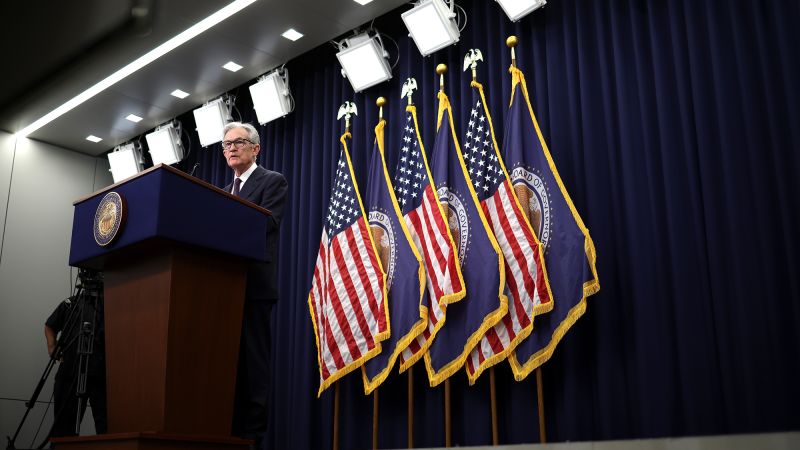Trump Administration Intensifies Pressure on Fed Chair Powell: A Battle for Economic Control?
The relationship between the White House and the Federal Reserve, often a delicate balance of power and independence, has once again become a focal point of political tension. Under the Trump administration, the pressure on Federal Reserve Chair Jerome Powell has reached a fever pitch, raising concerns about the future of monetary policy and the stability of the U.S. economy.
This article delves into the ongoing conflict, examining the accusations leveled against Powell, the potential motivations behind the administration’s actions, and the possible consequences of undermining the Fed’s independence.
Escalating Attacks: From Tweets to Official Accusations
The Trump administration’s discontent with Jerome Powell has been brewing for some time, marked by public criticism, personal insults, and now, formal accusations of misconduct. The latest salvo came in the form of a strongly worded letter from Russell Vought, Director of the Office of Management and Budget (OMB), accusing Powell of breaking the law by failing to comply with government oversight regulations and lying to Congress. This letter, posted prominently on social media, signals a significant escalation in the administration’s campaign against the Fed Chair.
Vought’s letter specifically targets a planned renovation of the Federal Reserve’s headquarters, alleging that the project’s rising costs and lack of transparency warrant serious concern. He suggests that Powell has been “plowing ahead with an ostentatious overhaul” instead of addressing more pressing fiscal matters.
This official rebuke comes on the heels of months of relentless criticism from President Trump, who appointed Powell during his first term. Trump has publicly berated Powell, even resorting to name-calling and suggesting he should resign. A recurring complaint revolves around interest rates, with Trump arguing that Powell has been “Too Late” in recognizing economic challenges and cutting rates aggressively enough.
The Core of the Conflict: Monetary Policy and Political Influence
At the heart of this conflict lies a fundamental disagreement over monetary policy. President Trump has consistently advocated for lower interest rates, believing they will stimulate economic growth and boost the stock market. This stance aligns with his focus on short-term economic gains and his desire to maintain a positive economic narrative.
However, the Federal Reserve, under Powell’s leadership, has maintained a more cautious approach. While some central banks have lowered rates, the Fed has largely held steady, citing a need to assess the impact of previous policy changes and to ensure that inflation remains under control.
This divergence in views has fueled Trump’s frustration, leading him to question Powell’s judgment and motives. The administration’s attacks, some argue, are a deliberate attempt to pressure Powell into adopting a more dovish stance, effectively politicizing monetary policy.
A Justification for Dismissal? Examining the Legality and the Fallout
The accusations against Powell raise the question of whether the administration is laying the groundwork for his dismissal. Ed Mills, a policy analyst at Raymond James, suggests that the focus on the Fed’s headquarters renovation could be a strategic move to find “cause” for firing Powell, circumventing potential legal challenges.
The legal framework surrounding the Fed Chair’s dismissal is complex. The Supreme Court has historically supported the Fed’s independence, making it difficult for the president to remove the Chair without a clear justification for cause, such as gross misconduct or violation of the law.
Dismissing Powell, however, carries significant risks. As Mills points out, such a move could send financial markets into turmoil, as investors lose faith in the Fed’s independence. The perception that monetary policy is being dictated by political considerations could lead to higher interest rates and economic instability.
Beyond Powell: A Broader Effort to Undermine the Fed
The pressure on Powell extends beyond the President’s pronouncements and Vought’s accusations. Other Trump administration officials, such as Peter Navarro, have publicly criticized Powell’s performance, and calls for congressional investigations have emerged.
Furthermore, the administration has taken steps to influence the oversight of the Fed’s headquarters renovation. The removal of three members of the National Capital Planning Commission, the federal government’s central planning agency for the region, and their replacement with Trump loyalists, demonstrates a calculated effort to exert control over the project.
James Blair, one of the new appointees to the commission, has already raised concerns about the renovation project, echoing the OMB’s allegations of non-compliance and potential dishonesty on Powell’s part.
These actions suggest a broader strategy to undermine Powell’s authority and to exert greater control over the Federal Reserve. The goal may not necessarily be to fire Powell outright, but rather to create a climate of pressure and uncertainty that forces him to align with the administration’s preferred policies or to resign.
The Importance of Fed Independence: A Cornerstone of Economic Stability
The Federal Reserve’s independence is a cornerstone of the U.S. economic system. It allows the Fed to make decisions based on economic data and analysis, rather than political considerations. This independence is crucial for maintaining price stability, promoting full employment, and ensuring the long-term health of the economy.
When political pressure interferes with the Fed’s decision-making process, it can have serious consequences. Inflationary expectations may rise, interest rates may become artificially manipulated, and the credibility of the central bank may be eroded.
The current conflict between the Trump administration and the Fed raises concerns about the erosion of this vital independence. The constant criticism, the personal attacks, and the accusations of misconduct all contribute to a climate of uncertainty and distrust, potentially undermining the Fed’s ability to effectively manage monetary policy.
Powell’s Response: A Study in Restraint
Throughout this escalating conflict, Jerome Powell has maintained a remarkably restrained public posture. He has consistently avoided responding directly to Trump’s criticisms, focusing instead on the Fed’s core mission of taming inflation and preserving the health of the labor market.
This strategy of avoiding direct confrontation has been praised by some as a demonstration of Powell’s commitment to the Fed’s independence. By refusing to engage in political sparring, he avoids further politicizing monetary policy and reinforces the Fed’s focus on objective economic data.
However, others have criticized Powell’s silence, arguing that he should be more assertive in defending the Fed’s independence and in pushing back against the administration’s attacks.
Ultimately, Powell’s approach reflects a careful calculation of the risks and benefits of different courses of action. He appears to believe that maintaining a professional and apolitical stance is the best way to protect the Fed’s credibility and to ensure its long-term effectiveness.
Potential Outcomes: A Fork in the Road for Monetary Policy
The conflict between the Trump administration and Jerome Powell could have several potential outcomes, each with significant implications for the U.S. economy.
- Powell Remains in Charge: Powell could weather the storm of criticism and continue to serve as Fed Chair until his term expires in 2026. In this scenario, the Fed would likely maintain its current cautious approach to monetary policy, gradually adjusting interest rates based on economic data.
- Powell Resigns: Faced with unrelenting pressure, Powell could choose to resign. This would create a vacancy at the head of the Fed, allowing the administration to appoint a successor who is more aligned with its preferred policies. However, such a move could trigger market volatility and damage the Fed’s credibility.
- Trump Attempts to Dismiss Powell: The administration could attempt to remove Powell “for cause,” based on the allegations of misconduct related to the Fed’s headquarters renovation. This scenario would likely lead to legal challenges and further undermine the Fed’s independence.
- The Status Quo Persists: The current state of tension and criticism could continue, with the administration continuing to pressure Powell and the Fed remaining largely independent. This scenario would create ongoing uncertainty and could potentially erode market confidence in the long run.
The most likely outcome is a continuation of the status quo, with the administration continuing to exert pressure on Powell while the Fed attempts to maintain its independence. However, the possibility of more dramatic scenarios cannot be ruled out, and the potential consequences for the U.S. economy are significant.
A Partisan Battle and its Implications on the Economy
The conflict between the Trump administration and the Fed Chair Jerome Powell is ultimately a partisan battle over the control of monetary policy. While the President has the right to express his opinion on the country’s economy, the politicization of the Fed could have long-term implications on the U.S. financial system and the economy as a whole. While the independence of the institution is a critical part of the economy, the question remains whether the White House can continue to pressure the Fed Chair for the benefit of the economy and the American people.
Conclusion: Navigating the Crossroads of Economic Independence
The ongoing conflict between the Trump administration and Federal Reserve Chair Jerome Powell represents a critical moment for the U.S. economy. The outcome of this struggle will determine the future of monetary policy and the degree to which political considerations will influence the decisions of the nation’s central bank.
Maintaining the Fed’s independence is essential for ensuring price stability, promoting full employment, and fostering long-term economic growth. Any actions that undermine this independence could have serious consequences for the U.S. economy and for the global financial system.
As this conflict unfolds, it is crucial for policymakers, economists, and the public to remain vigilant in protecting the integrity and independence of the Federal Reserve. The future of the U.S. economy may well depend on it.





